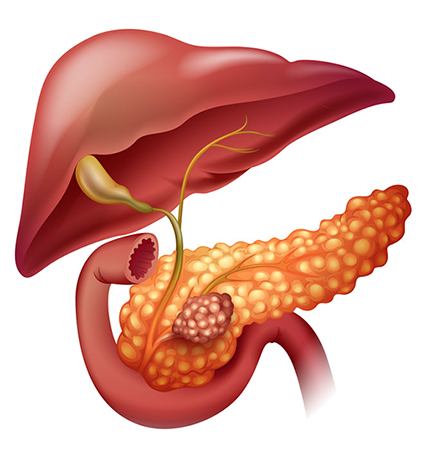Journey Through The GI Tract PART 5: The Pancreas

Here’s a quick recap. The digestive process begins in the mouth. It receives the food and breaks it up into small, easy-to-swallow pieces. Enzymes from the saliva break down any starch and the food passes into a long tube called the oesophagus. It carries the food bolus along its length, and contracts (peristalsis) to move food down towards the stomach. The enzymes and acids in the stomach continue the process of breaking down food, before they are released into the small intestine. The small intestine receives food from the stomach and continues to break down the food while absorbing the majority of its nutrients. In the upper section of your small intestine (duodenum), digestion continues as chyme from the stomach mixes with a variety of digestive juices from your pancreas, liver and gallbladder.
The Pancreas
Before we move onto the large intestine (otherwise know as the colon), there are three accessory digestive organs – pancreas, liver and gallbladder – that are instrumental in the digestive process. Let’s focus on the pancreas.
Your pancreas is located inside your abdomen, just behind the stomach. It’s about the size of your hand. During digestion, your pancreas makes pancreatic juices called enzymes. These enzymes break down sugars, fats, and starches. Your pancreas also helps your digestive system by making hormones. These are chemical messengers that travel through your blood. Pancreatic hormones help regulate your blood sugar levels and appetite, stimulate stomach acids, and tell your stomach when to empty.
Don’t take your pancreas for granted!
Although the pancreas is mostly known for its blood sugar regulatory function with the production of insulin, the organ produces digestive enzymes that help break down proteins, carbohydrates and fats.
Did you know? Your pancreas makes around 230ml of digestive juice filled with enzymes, daily!
Your pancreas creates natural juices called pancreatic enzymes to break down foods. These juices travel through your pancreas via ducts. They empty into the upper part of your small intestine called the duodenum. Pancreatic enzymes are:
- Lipase. This enzyme works together with bile, which your liver produces, to break down fat in your diet. If you don’t have enough lipase, your body will have an issue absorbing fat and the important fat-soluble vitamins (A, D, E, K). Symptoms of poor fat absorption include diarrhoea and fatty bowel movements.
- Protease. This enzyme breaks down proteins in your diet. It also helps protect you from germs that may live in your intestines, like certain bacteria and yeast. Undigested proteins can cause allergic reactions in some people.
- Amylase. This enzyme is predominantly produced by the salivary glands and the pancreas. It helps break down starches into sugar, which your body can use for energy.
Hormones
There are also pancreatic hormones that are produced inside your pancreas. Unlike enzymes that are released into your digestive system, hormones are released into your blood and carry messages to other parts of your digestive system. Insulin is one of them, which aids in the metabolism of sugars for energy.
So, you can see just how essential a role the pancreas plays! Your pancreas is important for digesting food and managing your use of sugar for energy after digestion. Treat it well.
Tune in next time, as we explore just how important our liver is for our digestion.
To find out about how to keep your digestive system working effectively, and to book your appointment, get in touch.
